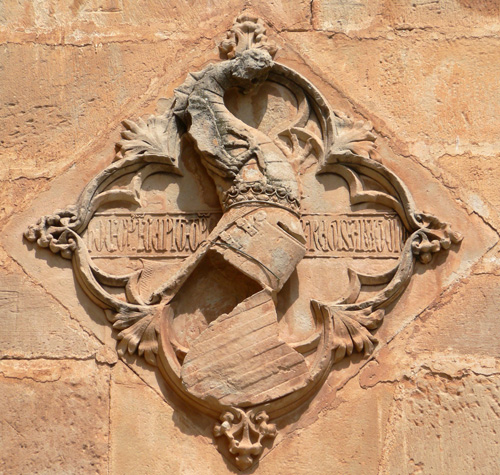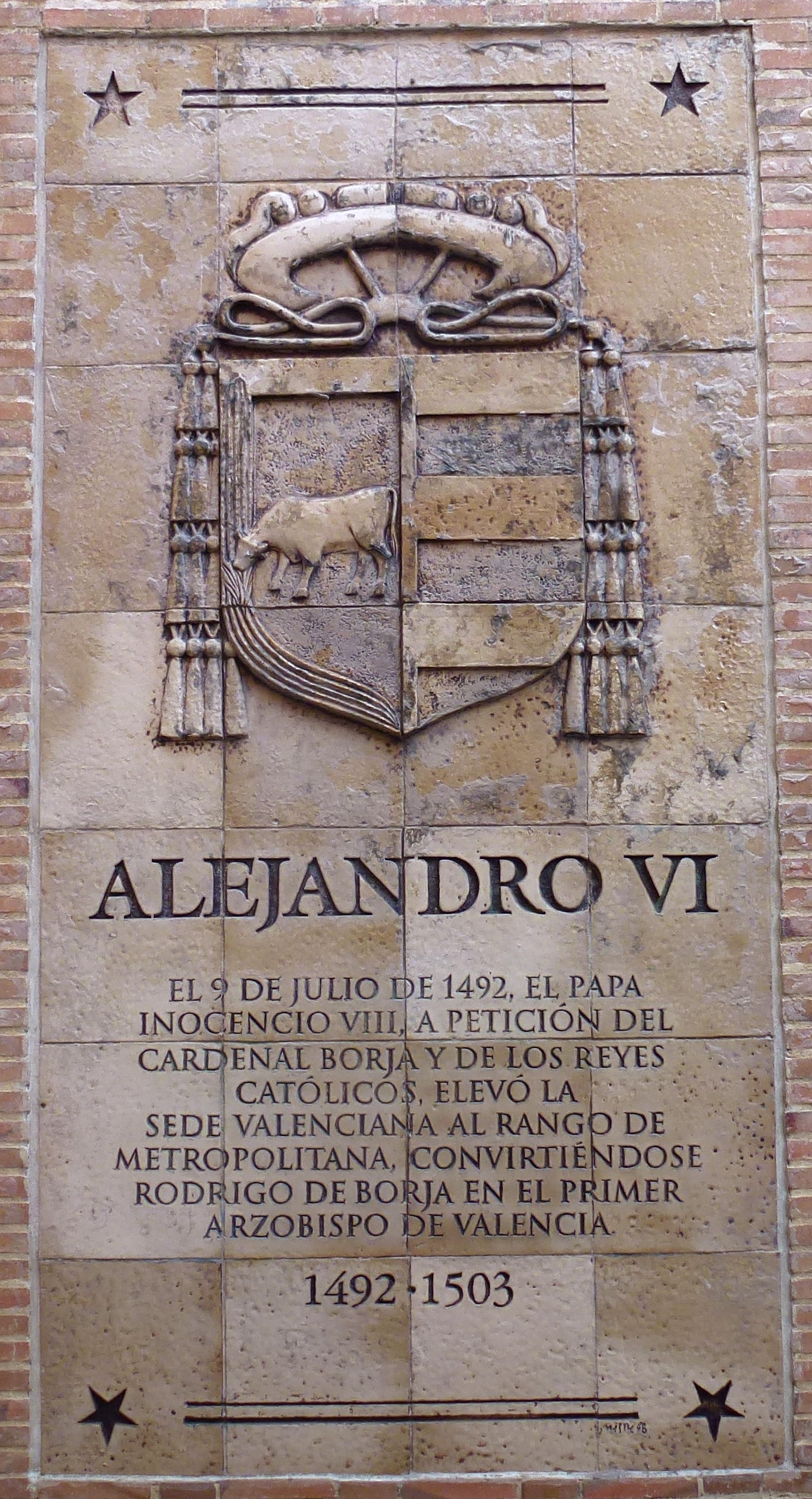|
Señorío De Torre De Canals
The Lordship of Torre de Canals was a lordship in the Crown of Aragon located in and around the town of Canals, Valencia, Torre de Canals. The town is located in the present day Valencian Community and no longer exists as a lordship. History Originally created by King James I of Aragon as a reward for Count Denis of Hungary, the title would eventually be inherited by a minor branch of the House of Borja (the main branch in the early- to mid-14th century, being based in Xàtiva). This minor branch would soon grow to eclipse the family's main branch with the ascension of two popes, Calixtus III and Alexander VI. Throughout their reign, the Borjas or Borgias maintained a base of power from the Torre de Canals and the greater Valencia region. A tower from their former palace still stands today. Calixtus III himself was actually born in this same palace, as it had belonged to his father, Juan Domingo de Borja y Doncel. In 1506, the Señorío was sold to the nearby city of Xàtiva, and t ... [...More Info...] [...Related Items...] OR: [Wikipedia] [Google] [Baidu] |
Crown Of Aragon
The Crown of Aragon (, ) ;, ; ; . was a composite monarchy ruled by one king, originated by the dynastic union of the Kingdom of Aragon and the County of Barcelona (later Principality of Catalonia) and ended as a consequence of the War of the Spanish Succession. At the height of its power in the 14th and 15th centuries, the Crown of Aragon was a thalassocracy controlling a large portion of present-day eastern Iberian Peninsula, parts of what is now Northern Catalonia, southern France, and a Mediterranean empire which included the Balearic Islands, Sicily, Corsica, Sardinia, Malta, Southern Italy (from 1442), and parts of Greece (until 1388). The component realms of the Crown were not united politically except at the level of the king, who ruled over each autonomous polity according to its own laws, raising funds under each tax structure, dealing separately with each ''Corts'' or ''Cortes'', particularly in the Kingdom of Aragon, the Principality of Catalonia, and the Kingdom of V ... [...More Info...] [...Related Items...] OR: [Wikipedia] [Google] [Baidu] |
History Of The Valencian Community
The Valencian Community is an autonomous community of Spain. It is the fourth most populous Spanish autonomous community after Andalusia, Catalonia and the Community of Madrid with more than five million inhabitants.Instituto Nacional de Estadística, Madrid, 2020. Its eponymous capital Valencia is the third largest city and metropolitan area in Spain. It is located along the Mediterranean coast on the east side of the Iberian Peninsula. It borders Catalonia to the north, Aragon and Castilla–La Mancha to the west, and Murcia to the south, and the Balearic Islands are to its east. The Valencian Community is divided into three provinces: Castellón, Valencia and Alicante. According to Valencia's Statute of Autonomy, the Valencian people are a '' "historical nationality"''. Their origins date back to the 1238 Aragonese conquest of the Taifa of Valencia. The newly-founded Kingdom of Valencia enjoyed its own legal entity and administrative institutions as a component of the Crown ... [...More Info...] [...Related Items...] OR: [Wikipedia] [Google] [Baidu] |
Peter IV Of Aragon
Peter IV (Catalan: ''Pere IV d'Aragó;'' Aragonese; ''Pero IV d'Aragón;'' 5 September 1319 – 6 January 1387), called the Ceremonious (Catalan: ''El Cerimoniós''; Aragonese: ''el Ceremonioso''), was from 1336 until his death the king of Aragon, king of Sardinia and Corsica, Sardinia-Corsica, and King of Valencia, Valencia, and count of Barcelona. In 1344, he deposed James III of Majorca and made himself King of Majorca. His reign was occupied with attempts to strengthen the crown against the Union of Aragon and other such devices of the nobility, with their near constant revolts, and with foreign wars, in Sardinia, Sicily, the Mezzogiorno, Latin Empire, Greece, and the Balearics. His wars in Greece made him Duke of Athens and Duchy of Neopatria, Neopatria in 1381. Succession conflicts Peter was born at Balaguer, the eldest son and heir of Alfonso IV of Aragon, Alfons IV, then Count of Urgell, and his first wife, Teresa d'Entença. Peter was designated to inherit all of ... [...More Info...] [...Related Items...] OR: [Wikipedia] [Google] [Baidu] |
Juan De Urrea
''Juan'' is a given name, the Spanish and Manx versions of ''John''. The name is of Hebrew origin and has the meaning "God has been gracious." It is very common in Spain and in other Spanish-speaking countries around the world and in the Philippines, and also in the Isle of Man (pronounced differently). The name is becoming popular around the world and can be pronounced differently according that region. In Spanish, the diminutive form (equivalent to ''Johnny'') is , with feminine form (comparable to ''Jane'', ''Joan'', or ''Joanna'') , and feminine diminutive (equivalent to ''Janet'', ''Janey'', ''Joanie'', etc.). Chinese terms * ( or 娟, 隽) 'beautiful, graceful' is a common given name for Chinese women. * () The Chinese character 卷, which in Mandarin is almost homophonic with the characters for the female name, is a division of a traditional Chinese manuscript or book and can be translated as 'fascicle', 'scroll', 'chapter', or 'volume'. Notable people * Juan (foo ... [...More Info...] [...Related Items...] OR: [Wikipedia] [Google] [Baidu] |
Bishop Of Tarazona
The Diocese of Tarazona () is a Latin diocese of the Catholic Church located in north-eastern Spain, in the provinces of Zaragoza, Soria, Navarre and La Rioja, forming part of the autonomous communities of Aragón, Castile-Leon, Navarre and La Rioja. The diocese forms part of the ecclesiastical province of Zaragoza, and is thus suffragan to the Archdiocese of Zaragoza."Diocese of Tarazona" ''''. David M. Cheney. Retrieved February 29, 2016 Episcopal see The city of is situated on a commanding point, surr ...[...More Info...] [...Related Items...] OR: [Wikipedia] [Google] [Baidu] |
Pedro De Urrea
Pedro is a masculine given name. Pedro is the Spanish, Portuguese, and Galician name for ''Peter''. Its French equivalent is Pierre while its English and Germanic form is Peter. The counterpart patronymic surname of the name Pedro, meaning "son of Peter" (compared with the English surname Peterson) is Pérez in Spanish, Peres in Galician and Portuguese, Pires also in Portuguese, and Peiris in coastal area of Sri Lanka (where it originated from the Portuguese version), with all ultimately meaning "son of Pero". The name Pedro is derived via the Latin word "petra", from the Greek word "η πέτρα" meaning "stone, rock". The name Peter itself is a translation of the Aramaic ''Kephas'' or '' Cephas'' meaning "stone". An alternative archaic variant is Pero. Notable people with the name Pedro include: Monarchs, mononymously *Pedro I of Portugal *Pedro II of Portugal *Pedro III of Portugal *Pedro IV of Portugal, also Pedro I of Brazil *Pedro V of Portugal *Pedro II of Braz ... [...More Info...] [...Related Items...] OR: [Wikipedia] [Google] [Baidu] |
Juan Domingo De Borja Y Doncel
Juan Domingo de Borja y Doncel (c. 1357 – ?) was the father of Pope Callixtus III. He held the title over the Barony La Torre de Canals. He was a member of the House of Borja. He was born in the Spanish village of the same name, Borja. Biography Domènec made his fortune in Xàtiva, where he was involved in local commerce, specifically in the sugar trade. He was the son of Domènec I de Borja and Caterina whose family name is not known. On 2 February 1375, Domènec de Borja, believed to be the father of Callixtus III, testified in a document as a citizen of Xàtiva. In 1404, Domènec was recorded as having been granted the title of ''Sobreguarda'' of the frontiers of the Kingdom of Castile by King Martin of Aragon In 1408, Domènec's son, Alfons de Borja i Cavanilles (future Pope Callixtus III), granted his father the power to collect the pension of a censor in Vall de Pego. Marriage and descendants Domènec de Borja married Francina Llançol, of Valencia, and the couple ... [...More Info...] [...Related Items...] OR: [Wikipedia] [Google] [Baidu] |
Canals, Valencia
Canals is a municipality (pop., INE 2007: 13,771) in the ''comarca'' of Costera in the Valencian Community, Spain. It shares borders with the municipalities of l'Alcúdia de Crespins, Cerdà, la Granja de la Costera, Xàtiva, Llanera de Ranes, Montesa, Torrella and Vallés (in the same ''comarca'') and with Aielo de Malferit and l'Olleria (''comarca'' of Vall d'Albaida). Geography Canals is located in the valley of Montesa, between the Grossa mountains and la Costera. The highest points are in la Serra Grossa, where we can find the peaks of l'Atalaia (556 m) and la Creu (520 m), on the municipal boundary with l'Olleria. The Cànyoles River crosses the town in the west-northeast direction; the Sants River begins its course close to town, where it divides into two channels (''séquies'') that bring water to Xàtiva and the fields of Canals. The village lies on the left bank of the Cànyoles river. Canals and l'Alcúdia de Crespins together form a conurbation. F ... [...More Info...] [...Related Items...] OR: [Wikipedia] [Google] [Baidu] |
Alexander VI
Pope Alexander VI (, , ; born Roderic Llançol i de Borja; epithet: ''Valentinus'' ("The Kingdom of Valencia, Valencian"); – 18 August 1503) was head of the Catholic Church and ruler of the Papal States from 11 August 1492 until his death in 1503. Born into the prominent House of Borgia, Borja family in Xàtiva in the Kingdom of Valencia under the Crown of Aragon, he was known as Roderic de Borja, and he is commonly referred to by the Italianized form as Rodrigo Borgia. He studied law at the University of Bologna. He was ordained deacon and made a Cardinal (Catholic Church), cardinal in 1456 after the election of his uncle as Pope Callixtus III, and a year later he became Apostolic Chancery, vice-chancellor of the Catholic Church. He proceeded to serve in the Roman Curia under the next four popes, acquiring significant influence and wealth in the process. In 1492, Rodrigo was elected pope, taking the name Alexander VI. Alexander's Inter caetera, papal bulls of 1493 confirm ... [...More Info...] [...Related Items...] OR: [Wikipedia] [Google] [Baidu] |
Calixtus III
Pope Callixtus III (, , ; 31 December 1378 – 6 August 1458), born Alonso de Borja (), was head of the Catholic Church and ruler of the Papal States from 8 April 1455 to his death, in August 1458. Borgia spent his early career as a professor of law at the University of Lleida; he later served as a diplomat for the kings of Aragon. He became a tutor for King Alfonso V's illegitimate son Ferdinand. After arranging a reconciliation between Alfonso and Pope Martin V, Borgia was made Bishop of Valencia. In 1444, Pope Eugene IV named him a cardinal, and Borgia became a member of the Roman Curia. During the siege of Belgrade (1456), Callixtus initiated the custom that bells be rung at midday to remind the faithful to pray for the crusaders. The tradition of the Angelus noon bell still exists in most Catholic churches to this day. He was also responsible for the retrial of Joan of Arc that saw her vindicated. He appointed two nephews as cardinals, one of whom became Pope Alexander ... [...More Info...] [...Related Items...] OR: [Wikipedia] [Google] [Baidu] |



